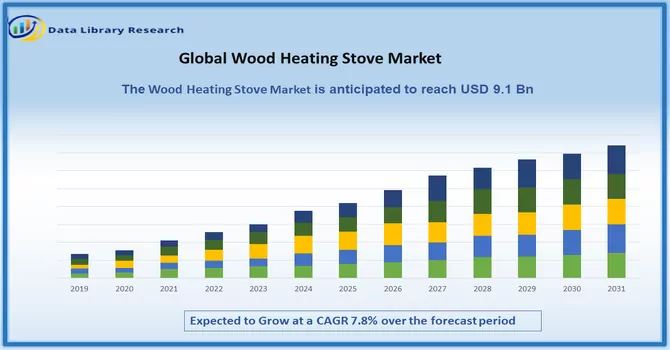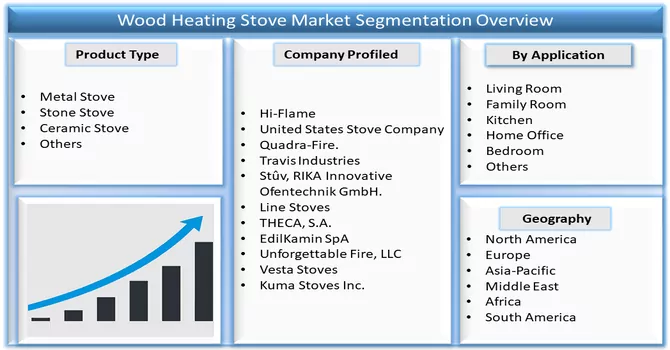The global Wood Heating Stoves Market size is valued at USD 9.1 Billion in 2023 and is projected to reach a CAGR of 7.8% over the forecast period, 2024-2031.

Get Complete Analysis Of The Report- Download Free Sample PDF
The global wood heating stoves market has witnessed steady growth as consumers increasingly seek sustainable and efficient heating solutions. With a rising awareness of environmental concerns and a shift towards renewable energy sources, wood heating stoves have gained popularity. These stoves offer an eco-friendly alternative, utilizing wood as a renewable and carbon-neutral fuel. The market is characterized by innovations in design and technology, focusing on improving efficiency and reducing emissions.
Governments' initiatives promoting the use of biomass for heating further contribute to the market's expansion. As the demand for energy-efficient and environmentally friendly heating options continues to rise, the global wood heating stoves market is poised for sustained growth. The growth of the global wood heating stoves market is primarily driven by the increasing demand for sustainable and eco-friendly heating solutions. As environmental awareness rises, consumers are actively seeking alternatives that reduce their carbon footprint. Wood heating stoves, utilizing wood as a renewable and carbon-neutral fuel source, align with these sustainability goals. The market is further propelled by innovations in design and technology aimed at enhancing efficiency and minimizing emissions. Government initiatives promoting the adoption of biomass for heating purposes also contribute to the market's expansion. With a growing emphasis on energy efficiency and environmentally conscious choices, the global wood heating stoves market is experiencing significant momentum.
Market Segmentation: The Global Wood Heating Stoves Market, By Types (Metal Stove, Stone Stove, Ceramic Stove, Others), Application (Living Room, Family Room, Kitchen, Home Office, Bedroom, Others), and Geography (Asia-Pacific, North America, Europe, South America, and Middle East and Africa). The report offers market size and forecasts for pyrolysis oil in terms of revenue in USD million for all the above-mentioned segments.

For Detailed Market Segmentation - Download Free Sample PDF
The global wood heating stoves market is witnessing several key trends that shape its dynamics. One notable trend is the integration of smart and connected features in wood stoves, offering users enhanced control over heating settings through mobile applications. This not only provides convenience but also aligns with the broader trend of home automation. Additionally, there is a discernible shift towards modern and aesthetically pleasing designs, making wood stoves a focal point in home décor. Improved combustion technologies, such as advanced air supply systems and emission control mechanisms, are gaining prominence, addressing concerns about environmental impact. The market is also seeing a rise in the popularity of multi-fuel stoves, offering versatility in fuel options. As sustainability and innovation continue to drive consumer preferences, these trends are likely to shape the future trajectory of the global wood heating stoves market.
Market Drivers:
Rising Demand for Sustainable Heating Solutions
The increasing awareness and concern about environmental sustainability are driving the demand for wood heating stoves. Consumers are actively seeking heating solutions that utilize renewable and eco-friendly fuel sources, and wood, when sourced responsibly, aligns with these preferences. Governments and regulatory bodies promoting clean energy solutions further contribute to the growing adoption of wood heating stoves.
Focus on Energy Efficiency and Cost Savings
Wood heating stoves are becoming popular due to their energy efficiency and cost-effectiveness. Modern stoves are designed with advanced combustion technologies that maximize heat output while minimizing fuel consumption. Consumers are attracted to the potential cost savings associated with using wood as a heating fuel compared to traditional energy sources. Additionally, the ability of wood stoves to provide warmth even during power outages enhances their appeal, especially in regions prone to extreme weather conditions.
Market Restraints:
Despite the positive trends, the global wood heating stoves market faces several challenges and restraints that impact its growth. One significant restraint is the environmental concerns associated with wood burning. While wood is considered a renewable resource, inefficient combustion or the use of non-dry or treated wood can lead to increased emissions of particulate matter, carbon monoxide, and other pollutants. This environmental impact has raised regulatory scrutiny in some regions, leading to stricter emission standards for wood-burning appliances. Additionally, the availability and cost of quality wood fuel can pose challenges. Consumers may face difficulties in sourcing dry and seasoned wood, impacting the efficiency of the stoves and leading to increased maintenance costs. Moreover, the convenience of alternative heating methods, such as electric or gas-based systems, may deter some consumers from choosing wood heating stoves. These challenges highlight the importance of continued innovation in the industry to address environmental concerns, improve efficiency, and ensure the sustainability of wood heating as a viable option in the evolving energy landscape.
The global wood heating stoves market, like many industries, experienced the impacts of the COVID-19 pandemic. The pandemic led to disruptions in the supply chain, affecting the production and distribution of wood heating stoves. Lockdowns, travel restrictions, and social distancing measures hampered manufacturing activities, causing delays in the delivery of components and finished products. Additionally, economic uncertainties and job losses during the pandemic affected consumer spending patterns, influencing the demand for wood heating stoves. The focus on health and safety during the pandemic also prompted consumers to reassess their home heating choices, with some opting for more convenient and cleaner alternatives. Despite these challenges, the market also witnessed increased interest in home improvement projects, as people spent more time indoors, leading to a mixed impact on the wood heating stoves market. The long-term effects of the pandemic underscore the need for adaptability and resilience within the industry.
Segmental Analysis:
Metal Stove Segment is Expected to Witness Significant Growth Over the Forecast Period
A metal stove is a type of heating appliance that uses metal as its primary material for construction. These stoves are designed to burn wood, pellets, coal, or other solid fuels to generate heat for residential or commercial spaces. Metal stoves come in various sizes, styles, and designs, ranging from traditional to modern, and can be freestanding or built into a fireplace. One of the key advantages of a metal stove is its efficiency in heating a space. Metal stoves are known for their high heat output and can effectively warm a room or an entire house, depending on their size and capacity. Additionally, metal stoves are durable and long-lasting, making them a cost-effective heating solution in the long run. Metal stoves are also known for their versatility and ease of installation. They can be installed in virtually any room with proper ventilation and clearance requirements. Furthermore, metal stoves are relatively easy to maintain and clean, ensuring optimal performance and safety. In conclusion, metal stoves are a popular choice for heating homes and buildings due to their efficiency, durability, versatility, and ease of installation. Whether for aesthetic or practical reasons, metal stoves remain a reliable and effective heating solution for many households and businesses.
Living Room Segment is Expected to Witness Significant Growth Over the Forecast Period
The living room is often the heart of a home, where families gather to relax and spend time together. In many homes, especially those in colder climates, heating stoves play a crucial role in keeping the living room warm and comfortable. Heating stoves are available in various types and styles, including wood-burning, pellet, gas, and electric stoves, each offering unique benefits and aesthetics. Wood-burning stoves are popular for their rustic charm and ability to provide a cozy ambiance. They are fueled by wood logs and can efficiently heat a room while adding a traditional touch to the decor. Pellet stoves are another popular option, using compressed wood or biomass pellets as fuel. They are known for their convenience and eco-friendliness, as they burn cleaner than traditional wood stoves. Gas and electric stoves offer the convenience of easy operation and precise temperature control. Gas stoves can be fueled by natural gas or propane and provide instant heat at the flip of a switch. Electric stoves are energy-efficient and require no venting, making them easy to install in any room. Thus, heating stoves are not only functional but also add aesthetic value to the living room, creating a warm and inviting atmosphere for family and guests alike.

Get Complete Analysis Of The Report- Download Free Sample PDF
The analyzed market exhibits a high degree of fragmentation, primarily attributable to the presence of numerous players operating on both a global and regional scale. The competitive landscape is characterized by a diverse array of companies, each contributing to the overall market dynamics. This fragmentation arises from the existence of specialized solution providers, established industry players, and emerging entrants, all vying for market share. The diversity in market participants is underscored by the adoption of various strategies aimed at expanding the company presence. On a global scale, companies within the studied market are strategically positioning themselves through aggressive expansion initiatives. This often involves entering new geographical regions, targeting untapped markets, and establishing a robust global footprint. The pursuit of global expansion is driven by the recognition of diverse market opportunities and the desire to capitalize on emerging trends and demands across different regions. Simultaneously, at the regional level, companies are tailoring their approaches to align with local market dynamics. Regional players are leveraging their understanding of specific market nuances, regulatory environments, and consumer preferences to gain a competitive edge. This regional focus allows companies to cater to the unique needs of local clientele, fostering stronger market penetration. To navigate the complexities of the fragmented market, companies are implementing a range of strategies. These strategies include investments in research and development to stay at the forefront of technological advancements, mergers and acquisitions to consolidate market share, strategic partnerships for synergies, and innovation to differentiate products and services. The adoption of such multifaceted strategies reflects the competitive nature of the market, with participants continually seeking avenues for growth and sustainability. In essence, the high fragmentation in the studied market not only signifies the diversity of players but also underscores the dynamism and competitiveness that drive ongoing strategic maneuvers. As companies explore various avenues for expansion, the market continues to evolve, presenting both challenges and opportunities for industry stakeholders.
The major players operating in the wood heating stoves market report are:
Recent Development:
1) In 2021, a team of researchers at Oregon State University secured a $2.5 million federal grant to address the issue of harmful emissions from wood-burning stoves, particularly prevalent in Native American communities and low-resource areas across the United States. Led by Nordica MacCarty from the OSU College of Engineering, the team aims to develop a firebox retrofit that utilizes turbulent jets of air to enhance the efficiency and cleanliness of wood-burning stoves, even when operating under less-than-ideal conditions such as wet wood or excessive fuel. This innovative approach not only promises to reduce emissions but also improve the overall performance of wood-burning stoves, making them a more sustainable and environmentally friendly heating option. By working closely with tribal and industry partners, the team hopes to create a retrofit solution that can be easily adopted and implemented in a variety of settings, thereby contributing to the broader goal of reducing air pollution and improving indoor air quality in communities reliant on wood-burning stoves.
Q1. What is the current Wood Heating Stove Market size?
As per Data Library Research the global Wood Heating Stoves Market size is valued at USD 9.1 Billion in 2023.
Q2. What is the Growth Rate of the Wood Heating Stove Market ?
Wood Heating Stove market is projected to reach a CAGR of 7.8% over the forecast period.
Q3. What are the factors driving the Wood Heating Stove market?
Key factors that are driving the growth include the Rising Demand for Sustainable Heating Solutions and Focus on Energy Efficiency and Cost Savings.
Q4. Who are the key players in Wood Heating Stove Market?
Some key players operating in the market include
Data Library Research are conducted by industry experts who offer insight on industry structure, market segmentations technology assessment and competitive landscape (CL), and penetration, as well as on emerging trends. Their analysis is based on primary interviews (~ 80%) and secondary research (~ 20%) as well as years of professional expertise in their respective industries. Adding to this, by analysing historical trends and current market positions, our analysts predict where the market will be headed for the next five years. Furthermore, the varying trends of segment & categories geographically presented are also studied and the estimated based on the primary & secondary research.
In this particular report from the supply side Data Library Research has conducted primary surveys (interviews) with the key level executives (VP, CEO’s, Marketing Director, Business Development Manager and SOFT) of the companies that active & prominent as well as the midsized organization
FIGURE 1: DLR RESEARH PROCESS

Extensive primary research was conducted to gain a deeper insight of the market and industry performance. The analysis is based on both primary and secondary research as well as years of professional expertise in the respective industries.
In addition to analysing current and historical trends, our analysts predict where the market is headed over the next five years.
It varies by segment for these categories geographically presented in the list of market tables. Speaking about this particular report we have conducted primary surveys (interviews) with the key level executives (VP, CEO’s, Marketing Director, Business Development Manager and many more) of the major players active in the market.
Secondary ResearchSecondary research was mainly used to collect and identify information useful for the extensive, technical, market-oriented, and Friend’s study of the Global Extra Neutral Alcohol. It was also used to obtain key information about major players, market classification and segmentation according to the industry trends, geographical markets, and developments related to the market and technology perspectives. For this study, analysts have gathered information from various credible sources, such as annual reports, sec filings, journals, white papers, SOFT presentations, and company web sites.
Market Size EstimationBoth, top-down and bottom-up approaches were used to estimate and validate the size of the Global market and to estimate the size of various other dependent submarkets in the overall Extra Neutral Alcohol. The key players in the market were identified through secondary research and their market contributions in the respective geographies were determined through primary and secondary research.
Forecast Model
